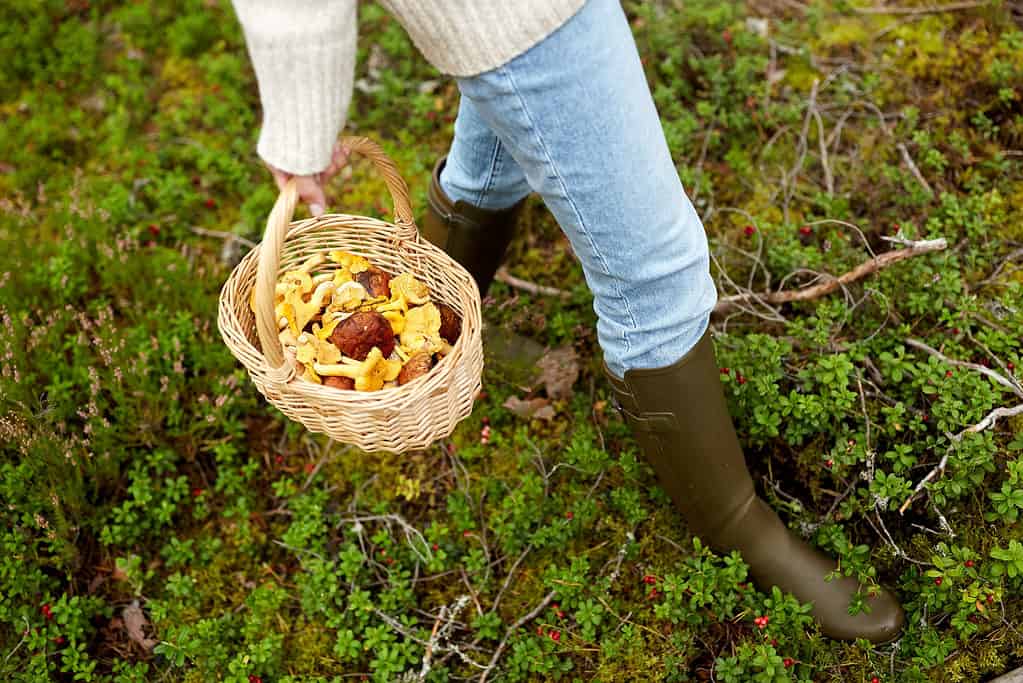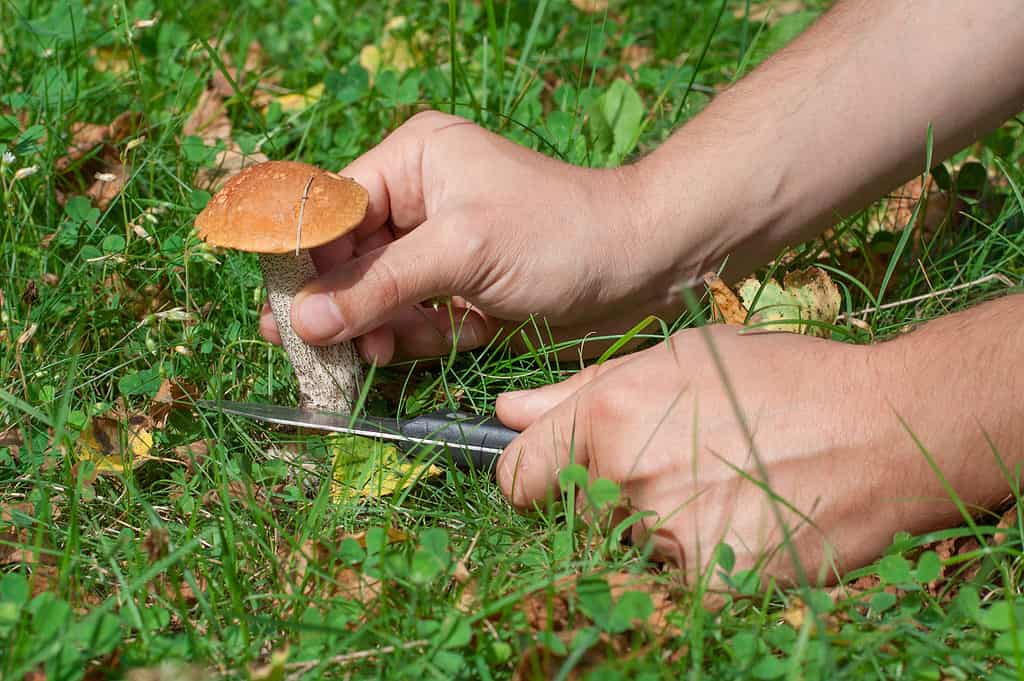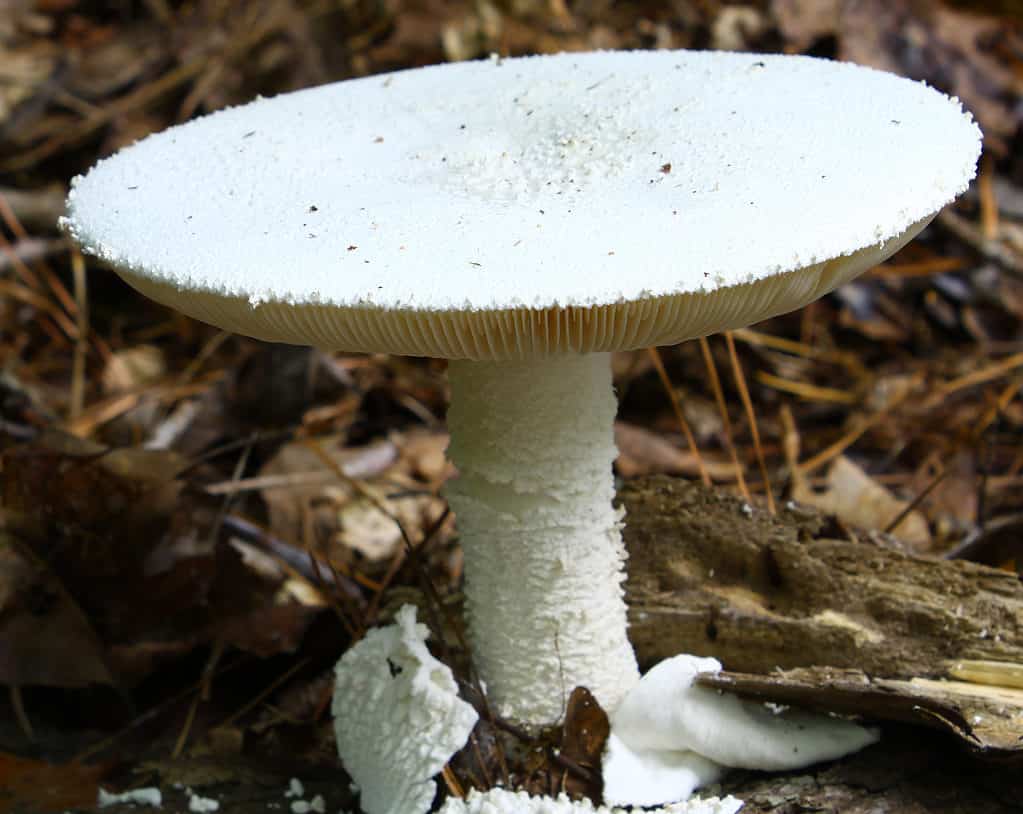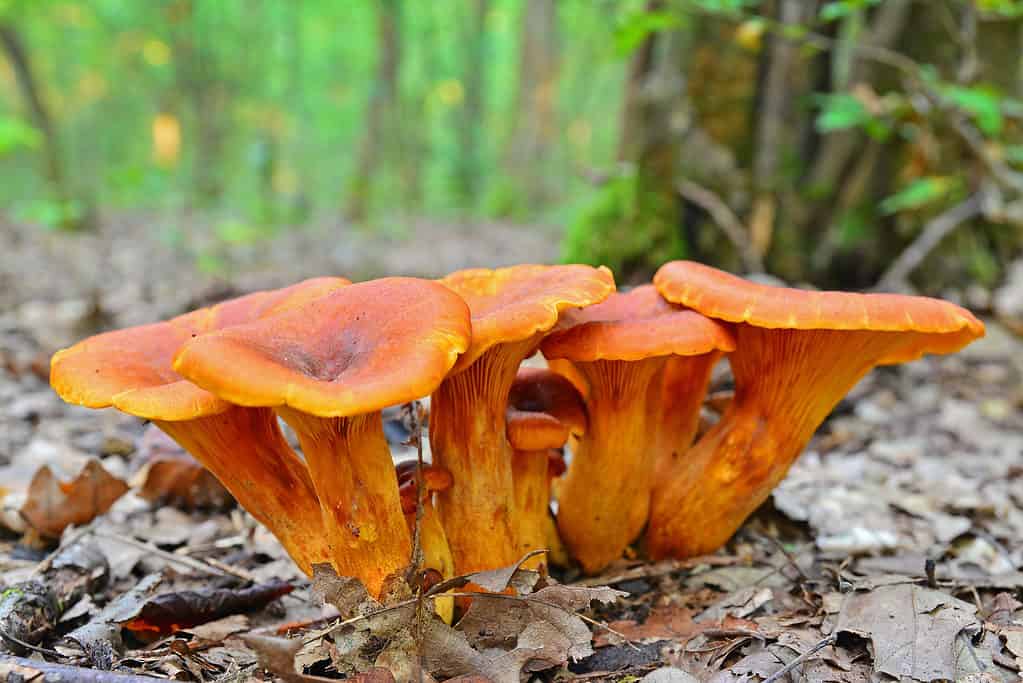Thinking of Michigan’s nature often brings up images of snowy landscapes and frozen trees, but this state isn’t all snow! In fact, Michigan’s parks and forests are buzzing with wildlife in the warmer months. This- of course – includes mushroom life!
Did you know that Mesick, MI is considered the mushroom capital of the U.S.?
There’s an amazing variety of mushrooms that grow in Michigan including many popular edible species. Even if you’re not aiming to collect mushrooms to eat, there are many species to discover and learn about! Many mushroom hunters go out into the forest simply to learn more about identifying mushrooms and the local ecosystem.
Whether you’re interested in collecting for the table or building your mushroom knowledge, this is a great place to start!
In this article, I’ll describe several local species, laws about collecting mushrooms, when to go, and much more!
Getting Started
One of the greatest worries for anyone learning to forage wild food is that they’ll pick and eat something toxic. This is important to keep in mind but don’t let this fear be an obstacle to ever starting!
When hunting for wild mushrooms, you should only eat a mushroom if you’re 100% sure of the species. If you have any doubts, simply don’t eat the mushroom. Instead, you can take pictures or bring them home to study further.
If you’re just beginning, the best way to build up your knowledge is to go out into the forest and practice identifying mushrooms. Mushroom hunting is more so about studying mushrooms and finding them in the forest – eating them is just a bonus!
Even experienced mushroom hunters come home empty-handed all the time, so don’t be discouraged at first. Over time you’ll build up lots of knowledge about mushrooms and the forests around you!

When hunting for wild mushrooms, you should only eat a mushroom if you’re 100% sure of the species.
©Fotorina/Shutterstock.com
Resources for Michigan Mushroom Hunting
Mycology – the study of mushrooms – is a whole world in itself. There’s so much to learn and even the experts claim they’re not experts. Don’t be intimated by how much there is to learn! Mushroom hunting is a hobby people continue to learn about their whole lives.
Mushroom hunting is quite popular in Michigan, which means that there are tons of resources to tap into! Even the Michigan Department of Natural Resources has an online Guide to Mushrooms.
However, the best way to build your knowledge is to join a group. By joining a group you can meet experienced mushroom hunters who share their knowledge, local spots, and stories about foraging.
The Michigan Mushroom Hunters Club has guided hunts both for the public and for members only. Foraging with and asking advice from experienced “mushroomers” helps you gain confidence about your finds and learn tricks to correctly identify mushrooms.
Michigan’s statewide mushroom hype means that all these people need a place to get together! That’s why there’s an annual Mesick Mushroom Festival where you can eat tasty mushrooms, listen to live music, and enjoy the conviviality of fellow mushroom lovers!
There’s also a National Morel Mushroom Festival dedicated to the delectable morel mushrooms. This festival is at the end of May in Boyne City. Here they also have cooked mushrooms, arts and crafts, and even a morel hunting contest!
Laws and Regulations
Some of the most important information about mushroom hunting in Michigan is how to do it legally. Although mushrooms grow wherever they want, you can’t pick them from wherever you want! These regulations are in place to ensure that mushrooms aren’t over-harvested.
All of these rules and regulations are for collecting mushrooms for personal use only. You need a commercial permit if you want to collect mushrooms to sell. The Midwest American Mycological Information hosts workshops to train and certify people to sell foraged mushrooms if you’re interested!
You don’t need a permit to collect mushrooms in the National Forests. The US Forest Service doesn’t have a maximum amount that you can take from the forest, but be reasonable and mindful of others!
In Michigan, mushroom hunting is allowed on all state property. This includes state forests, parks, and recreation areas. Again, there’s no maximum on what you can collect but use your discretion.
Some counties allow mushroom hunting in parks and some don’t. If you would like to collect mushrooms from local natural spaces, it’s best to call the office number for your county and get direct permission.
You can only collect mushrooms from private property with explicit permission from the owner. Many people are kind and don’t mind, so always ask first!

Woman with mushrooms from foraging in a wicker basket.
©iStock.com/dolgachov
Foraging Tips
Along with the official laws for collecting mushrooms, there are a few rules we follow to forage in a way that’s responsible and respectful to Nature.
First off- and this applies to foraging any wild edible – only take what you’ll use. Aside from you, there are other mushroom hunters and forest animals that would like to eat wild mushrooms! Plus, mushrooms play a vital role in forest ecosystems, and harvesting more than you’ll use can have a greater impact than you suspect.
When looking for mushrooms, don’t aggressively rake leaves or dig up plants. This disturbs both plants and wildlife. In some parks or forests, digging and raking are prohibited and you can be fined for this.
For collecting mushrooms, bring a bag with a natural material like paper or a wicker basket. Plastic traps humidity and can cause the mushrooms to deteriorate quickly. It’s also useful to bring a pocket knife or a small brush to snip and clean the mushrooms when you harvest them.

For collecting mushrooms it is useful to bring a pocket knife to cut the mushrooms for collection.
©iStock.com/siaivo
Foraging for Edible Mushrooms
Among the many species in Michigan, many edible mushrooms are loved by mushroom hunters and chefs all over the country.
Thankfully, there’s only a small percentage of mushrooms that are toxic, but this doesn’t mean that most mushrooms are edible. There’s a handful of mushrooms that are edible and super tasty, and these are called “choice edibles.”
However, even with the decidedly best edible mushrooms, you always need to cook a wild mushroom before eating it. Mushrooms decompose and absorb the environment they grow in, which means they could absorb chemicals or harsh minerals in the soil around them. Cooking the mushrooms helps get rid of any toxins they may have soaked up.
For the same reason, it’s important to only eat mushrooms that came from clean environments. Mushrooms that grow along busy roads or on fertilized lawns can absorb lots of harmful chemicals and change their credibility.
Local Edible Mushrooms
Morels (Morchella spp.) are a top choice edible that grows in the spring. In Michigan, they can be found from mid-April to late June, although this highly depends on the weather. They can be found in forests with White and Red pines, or Poplar, Ash, or Aspen trees. This interactive map shows various places where Morels might be found- but there’s no guarantee!
Chanterelles (Cantharellus spp.) are another wild favorite, coming right after Morels. If the summer is mild enough, Chanterelles can grow from May through October. In the fall, look out for their toxic lookalikes, Jack O’Lanterns– which I’ll describe in the next section.
Oyster mushrooms (Pleurotus ostreatus) are popular mushrooms because they can easily be grown at home- but they also grow wild in the forests of Michigan. Oyster mushrooms are most often found as gray-white or gray-brown but they are also pink or yellow species!
Pleurotus ostreatus can grow all year long if there’s enough moisture- they don’t mind hot or cold! However, other species like Pleurotus popullinus and Pleurotus pulmonarius are limited to the end of summer.
Michigan is also home to medical mushrooms like lion’s mane and reishi. Lion‘s mane grows as a large block on pieces of wood with dangling “hairs” that give it its name. Reishi is a shelf mushroom that is said to improve the immune system and grows all year long!
Common Toxic Mushrooms
When learning to identify wild mushrooms, it’s equally as important to learn about the toxic mushrooms as it is for the edible ones. By learning to properly identify the toxic mushrooms, you can be sure that what you’re about to bring home is not toxic.
You don’t have to be an expert but having a basic knowledge of the toxic mushrooms you might come across helps you steer clear and avoid any terrible mistakes.
One that should be at the top of your “do not pick” list is Amanita bisporigera, the “destroying angel.” If this mushroom’s name isn’t intimidating enough, it even looks foreboding. It’s a large mushroom that’s several inches tall with a cap that is equally as wide.
These mushrooms are all-white, from their stipe to their gills and cap. Sometimes they have a light pink tint or pale yellow tint. Amanitas often grow in forests with hardwoods, particularly Oaks, and grow individually.

is a large, toxic mushroom that is all white with a partial and universal veil.
©Barry Blackburn/Shutterstock.com
Be Aware of Toxic Lookalikes
Gyromitra spp. is often called the “false morel” because it can look like a morel to the untrained eye. They’re confused because they both have funky caps with wavy ridges on them. However, the more experience you gain, you’ll find that the two are pretty different!
| What to Look For | Real | False |
|---|---|---|
| Characteristic | Morel (Morchella spp.) | False morel (Gyromitra montana, G. esculenta) |
| Looks | Small, upright, honeycomb pattern on the cap | Flatter and lower to the ground, the cap is wavy and doesn’t have ridges as deep |
| Season | Spring | Spring |
| Distinguishing Factor | Hollow stipe | Solid stipe |
We have the same case with Chanterelles and their toxic lookalike, jack-o’lantern mushrooms (Omphalotus olearius). At first glance, these mushrooms look alike because they have similar colors but the more you study the two, you’ll find that their colors and forms are quite different.
| Characteristics | Chanterelles (Cantharellus spp.) | Jack o’lantern (Omphalotus olearius) |
| Looks | Orange-white color, false gills, wavy edges of the caps | Bright orange color, true gills, flatter caps |
| Season | End of summer and fall | End of summer and fall |
| Distinguishing Factor | Grows individually | Grows in clusters |

Jack-o’lantern mushrooms are toxic lookalikes to chanterelles.
©bogdan ionescu/Shutterstock.com
Where to Go Hunting in Michigan
Most experienced mushroom hunters are hesitant to give up their trusted hunting spots, and even less likely to share them on the internet. However, it still helps to have an idea of where you should be looking.
In general, mushrooms grow in places with lots of “forest fluff” – fallen leaves, branches, and bushes on the forest floor that provide nutrients to the underground mycelial network. You’re more likely to find mushrooms growing in undisturbed places – off the trails – but if you go off trail make sure to keep an eye on the trail so you know where you are.
However, the best way to search for mushrooms is to search for a particular species. As with any living thing, each species of mushroom has a native habitat where it grows. Some only grow with specific trees and some need certain conditions to grow.
The best way to get an idea of where to go is to study a certain species. This way, you’re not wandering around in an area that doesn’t have any of what you’re looking for.
Southern Michigan seems to be richer with mushroom hunting spots since the weather is more temperate there, but this doesn’t exclude the north. The Northern Peninsula also has many potential hunting spots, especially in the spring and summer when the weather is milder.
When to Go Hunting for Mushrooms
As with where to go hunting, the question of when to go is mostly determined by the species. However, even though each species has a growing season, there are lots of factors that affect mushroom growth.
All mushrooms need sufficient moisture, in the air and soil, to develop. So, going mushroom hunting after several days of rain is usually a good bet. In contrast, a drought or a dry period will lead to a very short mushroom season.
If the soil has been able to soak up consistent rainfall, the mushrooms will be ready to pop up! Plus, moisture in the air ensures that the mushrooms won’t dry up once they’re above ground.
Also, many mushrooms need mild temperatures and won’t grow well in extreme heat or cold. Most mushrooms either grow in the spring or late summer and fall. This is again why it’s important to do research about the exact species you’re searching for.
For these reasons, the general “mushroom season” is from March to November in Michigan. But, there are some species – like Oyster mushrooms – that can grow year-round.
Keep in mind that the temperatures and conditions change a lot from southern Michigan to the upper peninsula. Southern Michigan with have earlier seasons because it warms up sooner. In the northern peninsula, the soil takes longer to warm and the temperatures drop sooner, so the seasons will be shorter.

If the forest soil has been able to soak up consistent rainfall, mushrooms will be ready to pop up.
©iStock.com/Yury Karamanenko
What is The Tastiest Wild Mushroom?
Certain mushrooms renowned for their exquisite flavors include chicken of the woods, truffles, morels, porcini, shiitake, and portobello mushrooms. Interestingly, many of these delectable gourmet mushrooms are among the world’s priciest due to the challenges associated with their cultivation.
While some of these more flavorful mushrooms may be harder to find, there are a few delicious more commonly found species such as:
- Hen-of-the-woods
- Oyster
- Sulphur shelf mushrooms (Chicken of the Woods)
However, it’s crucial to note that while many wild mushrooms are safe to eat, some are not, and it is vital to know the differences before consumption!
Let the Hunt Begin!
I hope that reading this has gotten you excited to start mushroom hunting! If you’re ready to get out and start practicing, the best thing you can do is to join a club and go on the next guided foray.
Especially if you’re a beginner, it’s helpful to have an expert with you to give advice. Even if it’s not your first time foraging for fungi, you can be more sure of your finds when you have confirmation from several others – and it’s more fun going in a group!
No matter how long you’ve been hunting for mushrooms, it’s important to accept that there’s always more to learn! There’s always more research you can do, so by no means is this article the only thing you should read!
Yet, just as important as reading and studying is actually going out into the forest. One of the best ways to practice is to simply walk in the woods and gain awareness of the different fungi growing in the forest. In learning about mushrooms, you learn so much about the entire forest ecosystem!
The photo featured at the top of this post is © encierro/Shutterstock.com
The information presented on or through the Website is made available solely for general informational purposes. We do not warrant the accuracy, completeness, or usefulness of this information. Any reliance you place on such information is strictly at your own risk. We disclaim all liability and responsibility arising from any reliance placed on such materials by you or any other visitor to the Website, or by anyone who may be informed of any of its contents. None of the statements or claims on the Website should be taken as medical advice, health advice, or as confirmation that a plant, fungus, or other item is safe for consumption or will provide any health benefits. Anyone considering the health benefits of particular plant, fungus, or other item should first consult with a doctor or other medical professional. The statements made within this Website have not been evaluated by the Food and Drug Administration. These statements are not intended to diagnose, treat, cure or prevent any disease.
Thank you for reading! Have some feedback for us? Contact the AZ Animals editorial team.






